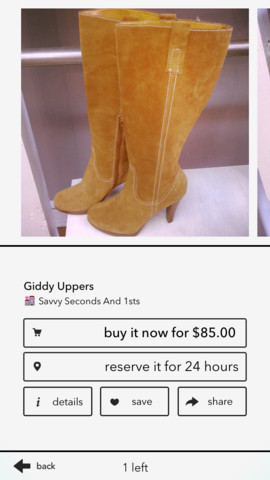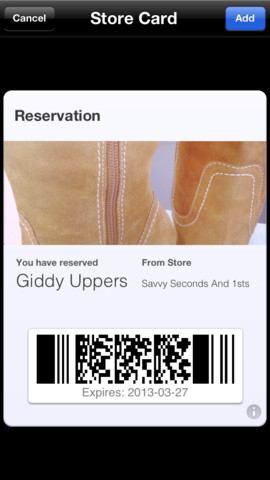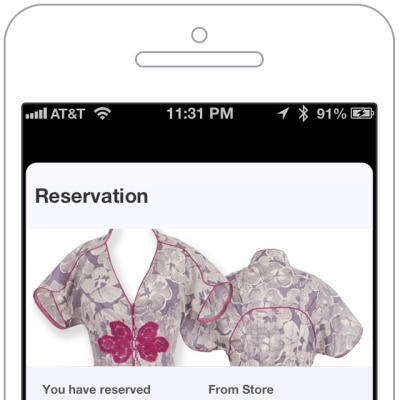Lightbank has invested $650,000 in its own Founder-in-Residence Josh Hernandez’s new startup, Walk.by, a platform for bringing local merchants into the e-commerce world by way of smartphones. The company is today announcing the release of its consumer-facing iPhone app which lets shoppers browse and follow offline retailers, the brands they carry, as well as very specific items, like “brown leather boots” or “black Kate Spade maxi dress,” for example.
 If one of Walk.by’s merchants has the product in stock, the shopper is alerted by push notification and can then choose to either purchase the item outright or place a reservation. The latter essentially means placing the item on hold so they can see it in person, or, in the case of apparel, go try it on.
If one of Walk.by’s merchants has the product in stock, the shopper is alerted by push notification and can then choose to either purchase the item outright or place a reservation. The latter essentially means placing the item on hold so they can see it in person, or, in the case of apparel, go try it on.
If they choose to buy, the merchant simply pops the item in a box, sticks on the shipping label Walk.by provides and sends the item out via UPS.
The result: local commerce, brought online, with minimal effort from merchants who may not even have an e-commerce site of their own…or even a website, for that matter.
The company was founded in September 2012, following Hernandez joining Lightbank in June. He had previously founded and sold Tap.Me, a mobile in-game advertising platform which was acquired by MediaMath in 2012. He also previously launched SectionZ Records in 2005, putting DJ Deadmau5 on the map, as well as SectionZ.com, a peer-to-peer musician community created back in 1999.
At Lightbank, Hernandez sat in on partner meetings, listening to pitches from entrepreneurs with ideas about how to connect online and offline retail. “It was all very complicated stuff, so I literally proposed to [Lightbank partners] Eric [Lefkofsky] and Brad [Keywell] that I wanted to take a stab at this, and put a more consumer-friendly face on how to manage inventory in your store via social media,” Hernandez explains. Lightbank let him do just that, funded him, and he soon he had built out team which actually includes Lefkofsky and Keywell as co-founders.
 Walk.by’s platform has two parts: a merchant application and a consumer application. On the merchant side, shop owners use an app called Walk.by Snap, which during this private testing period has been installed through Apple’s enterprise distribution system. However, the plan is to bring the merchant app to the Apple App Store in the near future, allowing any retailer with a physical presence to sign up.
Walk.by’s platform has two parts: a merchant application and a consumer application. On the merchant side, shop owners use an app called Walk.by Snap, which during this private testing period has been installed through Apple’s enterprise distribution system. However, the plan is to bring the merchant app to the Apple App Store in the near future, allowing any retailer with a physical presence to sign up.
With the merchant app, a store owner can take a photo of a product for sale and immediately post it to the Walk.by marketplace on mobile, as well as to all their social media accounts including Facebook, Twitter, Pinterest and, soon, YouTube. On its own, that’s already a powerful tool of sorts for a merchant to have on hand – these sellers today are often sharing items on social media in order to encourage foot traffic to their stores, and Walk.by’s app aims to simplify that process.
The app itself, Hernandez explains, is very much inspired by Instagram. It’s an easy-to-use camera application – and it even has filters, powered by Aviary.
“But with the launch of this consumer app, they’ll be able to respond to consumer demand,” Hernandez adds. “The app basically lets users follow stores, brands and even specific things. That will go to the merchants who have the relevant inventory that matches that terminology, and they’ll be able to respond with items on-demand.”
Now that the consumer app is live, merchants won’t just be posting to their social media accounts and Walk.by – they can respond directly to consumers interested in a product they have on hand with a photograph and other information.
“The idea is that this app will evolve into a communication channel directly between the merchants and customers,” says Hernandez. “It’s putting the personalization back into online shopping – this is what [merchants] are so good at in the store. What they’re missing online is that one-to-one connection.”
Merchants don’t pay for the app or to participate on Walk.by, nor do they pay for shipping – Walk.by provides the UPS label. Instead, the retailers pay a commission on sales, which ranges from 15 to 25 percent, depending on the store.
In the first two months the merchant platform was live, 54 active merchants sold over 120 items on the service. Today, there are 194 retailers signed up, but almost all of them are in Chicago, where Walk.by is based. But that doesn’t preclude them from shipping across the U.S.. Given that they don’t pay for shipping, a local sale costs them the same as a long-distance sale – it’s Walk.by itself that eats the shipping costs.
But Hernandez says that he was surprised to find that sometimes local shipping costs were higher than shipping cross-country, oddly. In the future, he plans to partner on local with other companies or startups offering messenger or delivery services. Of course, because merchants would still love the chance to get customers in the door for the chance at the upsell, a future version of the platform may introduce incentives for shoppers to come into the stores in person.
There’s still a “laundry list” of other things left to build, too, Hernandez notes, saying that the company is also looking into e-commerce website integrations, customizing the time-of-day of the push notifications, adding more communication functionality between customer and merchant, and more.
But for now, the platform itself is live and ready for a larger audience to try it out. Interested retailers can sign up with Walk.by here, and consumers can download the new app here in iTunes.
